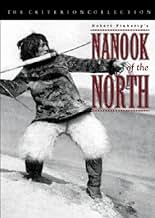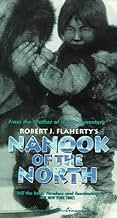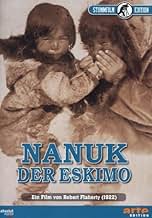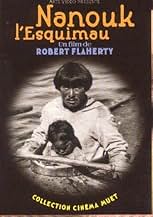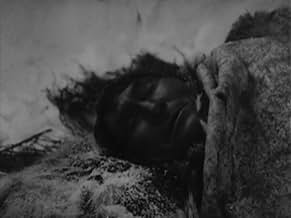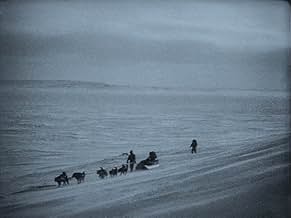CALIFICACIÓN DE IMDb
7.6/10
14 k
TU CALIFICACIÓN
En este predecesor mudo del documental moderno, el cineasta Robert J. Flaherty pasa un año siguiendo la vida de Nanook y su familia, inuits que viven en el Círculo Polar Ártico.En este predecesor mudo del documental moderno, el cineasta Robert J. Flaherty pasa un año siguiendo la vida de Nanook y su familia, inuits que viven en el Círculo Polar Ártico.En este predecesor mudo del documental moderno, el cineasta Robert J. Flaherty pasa un año siguiendo la vida de Nanook y su familia, inuits que viven en el Círculo Polar Ártico.
- Dirección
- Guionistas
- Elenco
- Premios
- 2 premios ganados en total
- Dirección
- Guionistas
- Todo el elenco y el equipo
- Producción, taquilla y más en IMDbPro
Opiniones destacadas
When looking back to the first documentary feature ever made, Nanook of the North comes up quick. Created by Robert Flaherty between 1916 and 1921 (mainly due to technical issues), the film was praised for being the first non-fictional feature ever made, in addition to capturing the unique lives of native eskimos that audiences at the time would not have expected. Part of that has to do with how much Flaherty worked so painfully hard to pull the whole thing together for so many years, all with the cooperation and patience of his subject, Allakariallak (a.k.a. Nanook). However, that in turn creates a massive conflict with this feature, being that it might not be as factually accurate as you think.
You see, even though the film documents the everyday actions of the Iniut people far up North, Flaherty actually took some creative liberties when crafting the film. In addition to the titular character not actually carrying the name Nanook in real life, his wives were actually played by Flaherty's real life wives, and even the weapons used in the film were not what the natives of the land really used. Allakariallak was actually quite accustomed to hunting with guns rather than spears. Also, the famous comical gramophone scene was all scripted, down to Allakariallak actually knowing what that type of machine was in real life. It really paints an inaccurate and frankly dishonest way of living through people who might not have even been known to international audiences any way.
However, despite the untrue facts shown throughout, the film still works well as a tale of bravery and innovation of the Inuit people up north. Many scenes are quite fascinating to view, including some of the hunts and even how the family operates. Regardless if several sequences were staged or not, much of what happens throughout the film inflicts a unique perspective of foreigners who may live differently from others. The very fact that Allakariallak spent his life around this region displays an earnest respect for both his people and the art of filmmaking in capturing such raw moments in a land one would never consider offering much. In a way, Flaherty wanted to document whilst simultaneously experimenting with the resources around far Northern Canada without degrading the virtues of eskimo livelihood.
So even if it may not be sophisticated in every single aspect, Nanook of the North still does a pretty good job in representing what residing up in a distinct region could be like. Sure, the film's flaws may anger those looking for pure facts, but in doing so, you'd fail to realize how much of a love letter the film is to a unique culture you may not have known about to begin with. Yes, it may not be completely right, but it at least presents itself through innovative craftsmanship unlike anything seen before its time. Besides, Flaherty has stated that much of what ended up in the film was conjured up through years of experimenting and well earned research of where he was shooting. I'm sure what he did is not too far off from what many filmmakers have done since then.
You see, even though the film documents the everyday actions of the Iniut people far up North, Flaherty actually took some creative liberties when crafting the film. In addition to the titular character not actually carrying the name Nanook in real life, his wives were actually played by Flaherty's real life wives, and even the weapons used in the film were not what the natives of the land really used. Allakariallak was actually quite accustomed to hunting with guns rather than spears. Also, the famous comical gramophone scene was all scripted, down to Allakariallak actually knowing what that type of machine was in real life. It really paints an inaccurate and frankly dishonest way of living through people who might not have even been known to international audiences any way.
However, despite the untrue facts shown throughout, the film still works well as a tale of bravery and innovation of the Inuit people up north. Many scenes are quite fascinating to view, including some of the hunts and even how the family operates. Regardless if several sequences were staged or not, much of what happens throughout the film inflicts a unique perspective of foreigners who may live differently from others. The very fact that Allakariallak spent his life around this region displays an earnest respect for both his people and the art of filmmaking in capturing such raw moments in a land one would never consider offering much. In a way, Flaherty wanted to document whilst simultaneously experimenting with the resources around far Northern Canada without degrading the virtues of eskimo livelihood.
So even if it may not be sophisticated in every single aspect, Nanook of the North still does a pretty good job in representing what residing up in a distinct region could be like. Sure, the film's flaws may anger those looking for pure facts, but in doing so, you'd fail to realize how much of a love letter the film is to a unique culture you may not have known about to begin with. Yes, it may not be completely right, but it at least presents itself through innovative craftsmanship unlike anything seen before its time. Besides, Flaherty has stated that much of what ended up in the film was conjured up through years of experimenting and well earned research of where he was shooting. I'm sure what he did is not too far off from what many filmmakers have done since then.
Years ago, in high school, I had to sit through a creaky, dim and dirty, silent black and white documentary about some Eskimo. I remember nothing of the film except that I didn't like it. Today, I had the opportunity to see a recently restored and nicely scored re-release of that film: Nanook of the North. After all the National Geographic, Nova, PBS and Discovery Channel documentaries I have seen over the years chronicling the lives of aboriginal bands of people, (aboriginal people often wearing Coca-Cola T-shirts and baseball caps), this classic 1922 epic is the best I've ever seen showing a happy people working desperately to survive in an incomprehensibly harsh environment. It is quite a compliment to the film and its subject that it retains so much power almost 80 years after it was created. The film simply documents a small group of Inuit and their children in northeast Canada as they struggle to live from day to day. That these people survive at all, let alone remain a seemingly happy, life-loving team in such a place is mind-boggling. So many of the brutally realistic scenes in this wonderful film remind me of how sterilized many contemporary documentaries have become. We see the necessary brutality of finding, stalking and killing your food. Then slicing up your kill right there on the ice and eating it where it died. We witness Nanook harpooning and then `reeling in' a walrus, catching fish with no hook and no real bait and somehow knowing where to dig a tiny hole in the ice. Then, through that tiny hole, he spears and battles to bring in a seal. And he succeeds. But more than the environment and more than the struggle, what keeps us watching this film is character. Nanook is the chief of the small tribe and the father in the main family that is followed. He is smart, curious, inventive, determined and, at the core, a happy, gregarious character that we learn to laugh with, root for and celebrate with as he keeps his family fed. His children are an absolute delight, playful and endearing, seemingly oblivious to the awful world in which they live. The film seems to have no artifice at all and everything seems to be a regular part of their life with little attention paid to the camera. If you are a lover of the documentary form, you cannot miss this re-release. It appears to have been struck from a near pristine negative and restored to its original length of somewhere over 65 minutes. The pleasant score is not too obtrusive and sounds as though it may be a reconstruction of the score composed for the theatrical re-release of the film in 1939, but the credits aren't completely clear on that. See this film.
This is a fascinating documentary from Robert Flaherty, a very prolific director of early documentaries. He follows the adventures of the Eskimo Nanook, and we get to see what life was like for the Eskimo in the early 20th Century as we watch Nanook with his family, hunting for food, and building igloos.
This is really amazing stuff for 1922. It feels like it could have been made long after that. That's probably due to the fact that it relies on real settings and real people. It's not bound by the restrictions of manufactured sets, costumes, etc. of the period. However, though it looks utterly authentic, don't be fooled into thinking that Flaherty gives us a purely realistic snapshot of Eskimo life. He planted the early seeds of reality t.v. with this film, making careful use of editing to create a narrative with all of the melodramatic trappings of any studio picture. Though it's a fascinating film, it's also a reminder that documentary film is just as manipulative as fiction, and that Michael Moore wasn't the first to corner the market on presenting fiction as fact.
Grade: A
This is really amazing stuff for 1922. It feels like it could have been made long after that. That's probably due to the fact that it relies on real settings and real people. It's not bound by the restrictions of manufactured sets, costumes, etc. of the period. However, though it looks utterly authentic, don't be fooled into thinking that Flaherty gives us a purely realistic snapshot of Eskimo life. He planted the early seeds of reality t.v. with this film, making careful use of editing to create a narrative with all of the melodramatic trappings of any studio picture. Though it's a fascinating film, it's also a reminder that documentary film is just as manipulative as fiction, and that Michael Moore wasn't the first to corner the market on presenting fiction as fact.
Grade: A
Robert Flaherty is one of the more noted documentarians in the history of film. It is not without some concentration (ironically maybe) to watch his most well-known work, Nanook of North, which is as much documentary as it is almost the very first widely seen "Home movie". There's no narration aside from the several title cards listing the obvious things that Nanook and his family/tribe are doing in the arctic.
Therefore this is much more of a visual kind of documentary, not as outrageous and experimental as those of Dziga Vertov of the same period (using what camera equipment available, shooting seemingly on the fly), but with a distinct view on what life is usually like for these people. We basically see them doing very elementary tasks, more based on living day-to-day in this harsh climate than anything overly dramatized.
That all of the scenes are really 'staged' (and, apparently, it's not even Nanook's real wife) doesn't deter the viewer from what is being shown. It's like a mix of the objective and subjective- objective in the sense that 'this is what it is, the Eskimos hunting for food, raising their children, making their shelter in igloos, and making trips to ensure their survival'. Subjective in that Flaherty's camera is creating a specific view of these people, their faces captured memorably in the scratchy print of the film. In a way it's also like the first, and perhaps more groundbreaking, of the lot of nature documentaries to follow over the years, though to a primitive extreme.
In all, Nanook of the North is meant to above all show the versatility of these people, both the physical nature (i.e. hunting the seal, which is the most exciting in the film) and the nature of the spirit of these people, living this way as a cycle over and over again.
Therefore this is much more of a visual kind of documentary, not as outrageous and experimental as those of Dziga Vertov of the same period (using what camera equipment available, shooting seemingly on the fly), but with a distinct view on what life is usually like for these people. We basically see them doing very elementary tasks, more based on living day-to-day in this harsh climate than anything overly dramatized.
That all of the scenes are really 'staged' (and, apparently, it's not even Nanook's real wife) doesn't deter the viewer from what is being shown. It's like a mix of the objective and subjective- objective in the sense that 'this is what it is, the Eskimos hunting for food, raising their children, making their shelter in igloos, and making trips to ensure their survival'. Subjective in that Flaherty's camera is creating a specific view of these people, their faces captured memorably in the scratchy print of the film. In a way it's also like the first, and perhaps more groundbreaking, of the lot of nature documentaries to follow over the years, though to a primitive extreme.
In all, Nanook of the North is meant to above all show the versatility of these people, both the physical nature (i.e. hunting the seal, which is the most exciting in the film) and the nature of the spirit of these people, living this way as a cycle over and over again.
As a documentary turning point, Nanook of the North is undoubtedly one of if not the most significant work of the twentieth century. The story of Nanook and his family became the center of attention of the national media and virtually altered the perceptions the world had of film for documentary purposes. Flaherty may be to the documentary world what J.R.R. Tolkien is to the fantasy world. He is the giant of the genre. For its time, Nanook of the North was a masterpiece. Simple and profound, the story of Nanook was unique, and henceforth the foundation upon which the great documentarians of the 20th century created their works. However, through hindsight, the film falters. Most noticeable is the fact that Flaherty composed each of these sequences ahead of time and purposefully altered Nanook's life in order to make it seem harsher. In what is one of the most famous scenes, Nanook laughs at a phonograph and bites into a record as if he does not understand it. However, it was discovered later that not only had Nanook seen phonographs before, but he was a regular visitor to the trading post, owned a snowmobile and a rifle, and had probably seen a record player before. This fact puts into question the strength of this work as a documentary. Flaherty defended himself, claiming that some things need to be altered in order for the message to be seen. However, this is what we in the film world call "fiction". Plenty of fiction is based upon fact, but when you call something a documentary, it is held up to a different standard, one that Flaherty's work, although, good, fails to achieve.
¿Sabías que…?
- TriviaThe claim that Allakariallak died of starvation in 1922, months after the film was completed, is untrue; he did not starve but likely succumbed to tuberculosis.
- Citas
Title Card: The shrill piping of the wind, the rasp and hiss of driving snow, the mournful wolf howls of Nanook's master dog typify the melancholy spirit of the North.
- Créditos curiososA story of life and love in the actual arctic.
- Versiones alternativasRemastered with image enhancement, speed correction and a new score in 1998
- ConexionesEdited into Saumialuk. Le grand gaucher (1990)
Selecciones populares
Inicia sesión para calificar y agrega a la lista de videos para obtener recomendaciones personalizadas
- How long is Nanook of the North?Con tecnología de Alexa
Detalles
Taquilla
- Presupuesto
- USD 53,000 (estimado)
- Tiempo de ejecución
- 1h 18min(78 min)
- Mezcla de sonido
- Relación de aspecto
- 1.33 : 1
Contribuir a esta página
Sugiere una edición o agrega el contenido que falta


